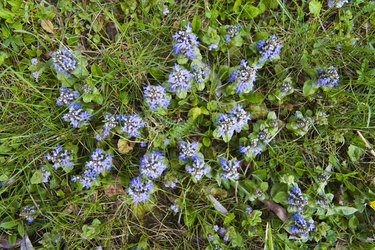Ground cover plants can help to protect soil and prevent erosion by absorbing water and preventing runoff. Not all types of plants are suitable for wet areas, so it's important to choose ground cover carefully for constantly wet areas or places that periodically flood.

Constantly Wet Areas
Many plants cannot thrive in places where the soil is constantly wet because the water prevents oxygen from reaching the roots. For these areas, plants that tolerate constant moisture are the only choice. These plants can utilize the moisture in the ground and won't be overwhelmed with too much of it.
Video of the Day
Video of the Day
Carpet Bugle

Carpet bugle (Ajuga reptans) is hardy in U.S. Department of Agriculture hardiness zones 3 through 9. This small evergreen gets about 12 inches tall and spreads to 2 feet across. It blooms with an abundance of small purple flowers during May and June, attracting birds, butterflies and hummingbirds. Carpet bugle thrives in rich, moist soil and is recommended by Clemson University for planting in wet or consistently damp areas. It may be invasive in some areas of the Unites States, mostly in the Eastern states.
Lilly of the Valley
Lilly of the valley (Convallaria majalis) does well in constantly wet soil, and according to Clemson University experts it's perfect for areas with a lot of ground moisture. It is a fast grower but gets no more than about a foot tall and spreads to a foot across. The dark green leaves give this plant a lush appearance and the tiny, bell-shaped white flowers add spring interest. This plant is hardy in USDA zones 3 through 8 and may be invasive in parts of the United States, particularly the Northeast.
Creeping Lilyturf
Creeping lilyturf (Liriope spicata) spreads rapidly to cover bare areas. This evergreen has a grassy appearance that grows to 12 inches tall and 18 inches wide. In the summer and early fall it puts out spikes of pale lavender flowers, which are then followed by small black berries. This plant is hardy in USDA zones 5 through 11 and needs plenty of moisture to survive. This plant has been reported as potentially invasive in a few isolated counties in the South.
Areas that Flood
Properties near rivers, ponds, lakes and creeks may sometimes be subjected to flooding, which can wreak havoc with plants. Landscaping with ground cover that can withstand occasional flooding will help to prevent erosion and preserve plants when the water gets too high.
Golden Creeper
Golden creeper (Ernodea littoralis) is a Florida native that's hardy in USDA zones 10B through 11. It averages 1 to 3 feet high with woody, undulating growth, yellow-green leaves, produces pink flowers all year and has golden berries on its stems throughout the year. The University of Florida IDAS Extension recommends this ground cover for areas that flood sporadically. This hardy native plant is suggested as an alternative to potentially invasive species throughout the south.
English Ivy
English ivy (Hedera helix 'Glacier') tolerates a wide range of soils, from fairly dry to very moist. 'Glacier' has attractive small leaves that may be either dark or light green with light, cream-colored edges. According to the University of Kentucky Extension, this plant can stand up to periodic flooding. When grown as ground cover it gets no more than 6 inches high and can spread up to 23 inches across. It is hardy in USDA zones 5 though 9. It has been reported to have invasive potential on the West Coast as well as in Florida and parts of the Midwest.
Chameleon Plant

The chameleon plant, (Houttuynia cordata 'Chameleon'), is a true water-lover and can be planted any place that collects excess water. 'Chameleon' gets its name from the light green leaves that feature bright splashes of pink, red, cream and yellow. It's a quick-spreading plant and may become invasive through its underground root system, so grow it in large, buried containers or bury a barricade 10 to 12 inches tall around the area to stop it from taking over.